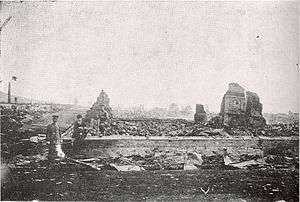Nikolayevsk incident
The Nikolayevsk incident (尼港事件 Niko Jiken) was a series of events from February through March 1920 during the Allied intervention in the Russian Civil War, culminating in the massacre of several hundred Japanese expatriates and most of the Russian inhabitants of the town of Nikolayevsk-on-Amur in the Russian Far East.[1]


Nikolayevsk-on-Amur was occupied in September 1918 by the Imperial Japanese Army as part of Japan's Siberian Intervention force. In early February 1920, the town had a Japanese civilian community of around 450 people, and a military garrison of 350 men from the Imperial Japanese Army's 14th Infantry Division. In addition to the Japanese presence, the Russian White Army housed a garrison of roughly 300 men. The total civilian population at the time was around 15,000. In January 1920, the town was surrounded by a partisan force nearly 4,000 strong under the command of Yakov Tryapitsyn, who was loosely allied with the Bolshevik Red Army.
On February 24, 1920, realizing that he was outnumbered and far from reinforcement, the commander of the Japanese garrison allowed Triapitsyn's troops to enter the town under a flag of truce. However, Triapitsyn began to round up and execute White Movement supporters, the only force holding his hand being the small Japanese garrison. On 10 March, he issued an ultimatum to the garrison to voluntarily disarm, to which he was sure the Japanese would not agree. Therefore, the Japanese intervened, launching a surprise attack on 12 March 1920. The attack failed and most of the Japanese troops died, the remaining few only surrendered when the Japanese high command ordered them to do so. Even so, Triapitsyn decided to take revenge, which resulted in the execution of the surviving garrison and the slaughter of all but 122 Japanese civilians – in all around 700 Japanese died shortly thereafter.[1]
After this, he was free to start a reign of terror and execute all those civilians he deemed dangerous to his forces. Being short with ammunition, one of the methods to execute the victims was to stab them with a bayonet and thrust them in a hole under the ice of the river Amur. Several thousand inhabitants of the town were killed like this and with other execution methods.[1]
In late May, as a Japanese relief expedition approached, Triapitsyn executed all of the remaining inhabitants of the town, both Japanese and Russian, and burned the town to the ground.[1]
The Japanese government lodged a protest against the Bolshevik government in Moscow, demanding compensation. The Russian government responded by capturing and executing Triapitsyn; however, the Japanese government felt that this was not sufficient, and used the incident as an excuse to occupy the northern half of Sakhalin island, and to delay diplomatic recognition of the Soviet Union until 1925.
References
- 1 2 3 4 The destruction of Nikolayevks-on-Amur: An episode in the Russian civil war in the Far East, book review in the Cambridge University Press.
- Hara, Teruyuki. Niko Jiken no Shomondai (Problems in the Incident at Nikolaevsk-na-Amure) // Roshiashi Kekyuu, 1975, No. 23.
- Gutman, Anatoly. Ella Lury Wiswell (trans.); Richard A. Pierce (ed.) The Destruction of Nikolaevsk-on-Amur, An Episode in the Russian Civil War in the Far East, 1920. Limestone Press (1993). ISBN 0-919642-35-7
- White, John Albert. The Siberian Intervention. Princeton University Press (1950)
Coordinates: 53°08′N 140°44′E / 53.133°N 140.733°E